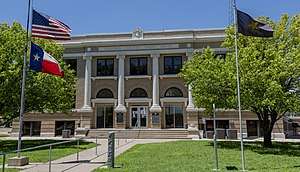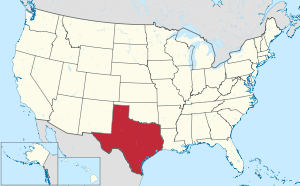Sherman County, Texas
Sherman County is a county located in the U.S. state of Texas. As of the 2010 census, its population was 3,034.[1] Its county seat is Stratford.[2] The county was created in 1876 and organized in 1889.[3] It is named for Sidney Sherman, who fought in the Texas Revolution.
Sherman County | |
|---|---|
 Sherman County Courthouse | |
 Location within the U.S. state of Texas | |
 Texas's location within the U.S. | |
| Coordinates: 36°17′N 101°53′W | |
| Country | |
| State | |
| Founded | 1889 |
| Named for | Sidney Sherman |
| Seat | Stratford |
| Largest city | Stratford |
| Area | |
| • Total | 923 sq mi (2,390 km2) |
| • Land | 923 sq mi (2,390 km2) |
| • Water | 0.2 sq mi (0.5 km2) 0.02%% |
| Population (2010) | |
| • Total | 3,034 |
| • Density | 3.3/sq mi (1.3/km2) |
| Time zone | UTC−6 (Central) |
| • Summer (DST) | UTC−5 (CDT) |
| Congressional district | 13th |
| Website | www |
Though both Sherman County and Sherman, Texas, are named for the same person, the city of Sherman is located in Grayson County, about 430 miles to the southeast.
Geography
According to the U.S. Census Bureau, the county has a total area of 923 square miles (2,390 km2), of which 923 square miles (2,390 km2) are land and 0.2 square miles (0.52 km2) (0.02%) is covered by water.[4]
Major highways



Adjacent counties
- Texas County, Oklahoma (north)
- Hansford County (east)
- Moore County (south)
- Dallam County (west)
- Cimarron County, Oklahoma (northwest)
- Hartley County (southwest)
- Hutchinson County (southeast)
Demographics
| Historical population | |||
|---|---|---|---|
| Census | Pop. | %± | |
| 1890 | 34 | — | |
| 1900 | 104 | 205.9% | |
| 1910 | 1,476 | 1,319.2% | |
| 1920 | 1,473 | −0.2% | |
| 1930 | 2,314 | 57.1% | |
| 1940 | 2,026 | −12.4% | |
| 1950 | 2,443 | 20.6% | |
| 1960 | 2,605 | 6.6% | |
| 1970 | 3,657 | 40.4% | |
| 1980 | 3,174 | −13.2% | |
| 1990 | 2,858 | −10.0% | |
| 2000 | 3,186 | 11.5% | |
| 2010 | 3,034 | −4.8% | |
| Est. 2019 | 3,022 | [5] | −0.4% |
| U.S. Decennial Census[6] 1850–2010[7] 2010–2014[1] | |||
As of the census[8] of 2000, 3,186 people, 1,124 households, and 865 families resided in the county. The population density was 4 people per square mile (1/km²). The 1,275 housing units averaged 1 per square mile (1/km²). The racial makeup of the county was 82.49% White, 0.53% African American, 0.66% Native American, 0.03% Asian, 14.63% from other races, and 1.66% from two or more races. About 27.43% of the population was Hispanic or Latino of any race. In terms of ancestry, 20.3% were German, 7.3% were English, 7.1% were of American, 5.5% were of Irish, 2.6% were of Scottish, and 1.9% were of Dutch.
Of the 1,124 households, 40.70% had children under the age of 18 living with them, 68.00% were married couples living together, 6.00% had a female householder with no husband present, and 23.00% were not families. About 21.50% of all households were made up of individuals, and 10.00% had someone living alone who was 65 years of age or older. The average household size was 2.76 and the average family size was 3.24.
In the county, the population was distributed as 31.40% under the age of 18, 7.00% from 18 to 24, 26.50% from 25 to 44, 21.50% from 45 to 64, and 13.60% who were 65 years of age or older. The median age was 34 years. For every 100 females, there were 102.50 males. For every 100 females age 18 and over, there were 95.70 males.
The median income for a household in the county was $33,179, and for a family was $38,821. Males had a median income of $27,481 versus $21,036 for females. The per capita income for the county was $17,210. About 11.90% of families and 16.10% of the population were below the poverty line, including 21.90% of those under age 18 and 12.00% of those age 65 or over.
Politics
| Year | Republican | Democratic | Third parties |
|---|---|---|---|
| 2016 | 86.3% 807 | 10.3% 96 | 3.4% 32 |
| 2012 | 87.5% 908 | 11.7% 121 | 0.9% 9 |
| 2008 | 86.7% 884 | 12.5% 127 | 0.9% 9 |
| 2004 | 88.4% 942 | 11.6% 124 | |
| 2000 | 85.8% 998 | 12.4% 144 | 1.8% 21 |
| 1996 | 70.8% 809 | 21.3% 243 | 8.0% 91 |
| 1992 | 62.2% 851 | 19.1% 261 | 18.8% 257 |
| 1988 | 76.4% 1,145 | 22.7% 340 | 0.9% 14 |
| 1984 | 83.3% 1,269 | 16.1% 246 | 0.6% 9 |
| 1980 | 77.5% 1,128 | 19.6% 286 | 2.9% 42 |
| 1976 | 48.0% 679 | 50.7% 718 | 1.3% 19 |
| 1972 | 84.3% 996 | 14.3% 169 | 1.4% 16 |
| 1968 | 51.8% 723 | 21.3% 297 | 26.9% 376 |
| 1964 | 57.6% 629 | 42.3% 462 | 0.1% 1 |
| 1960 | 69.1% 686 | 30.7% 305 | 0.2% 2 |
| 1956 | 55.4% 481 | 44.1% 383 | 0.6% 5 |
| 1952 | 67.7% 669 | 32.1% 317 | 0.2% 2 |
| 1948 | 16.6% 98 | 80.9% 479 | 2.5% 15 |
| 1944 | 16.6% 97 | 77.7% 454 | 5.7% 33 |
| 1940 | 13.4% 82 | 86.1% 528 | 0.5% 3 |
| 1936 | 5.7% 34 | 94.4% 568 | |
| 1932 | 14.9% 91 | 84.6% 515 | 0.5% 3 |
| 1928 | 64.4% 248 | 35.6% 137 | |
| 1924 | 29.0% 87 | 62.7% 188 | 8.3% 25 |
| 1920 | 30.7% 77 | 67.7% 170 | 1.6% 4 |
| 1916 | 19.3% 39 | 75.3% 152 | 5.5% 11 |
| 1912 | 14.5% 22 | 63.2% 96 | 22.4% 34 |
See also
References
- "State & County QuickFacts". United States Census Bureau. Retrieved December 24, 2013.
- "Find a County". National Association of Counties. Retrieved 2011-06-07.
- "Texas: Individual County Chronologies". Texas Atlas of Historical County Boundaries. The Newberry Library. 2008. Retrieved May 26, 2015.
- "2010 Census Gazetteer Files". United States Census Bureau. August 22, 2012. Retrieved May 10, 2015.
- "Population and Housing Unit Estimates". United States Census Bureau. May 24, 2020. Retrieved May 27, 2020.
- "U.S. Decennial Census". United States Census Bureau. Retrieved May 10, 2015.
- "Texas Almanac: Population History of Counties from 1850–2010" (PDF). Texas Almanac. Retrieved May 10, 2015.
- "U.S. Census website". United States Census Bureau. Retrieved 2011-05-14.
- Leip, David. "Dave Leip's Atlas of U.S. Presidential Elections". uselectionatlas.org. Retrieved 2018-07-30.
External links
| Wikimedia Commons has media related to Sherman County, Texas. |
- Sherman County government’s website
- Sherman County in Handbook of Texas Online at the University of Texas
- Sherman County Profile from the Texas Association of Counties
- Sketch of Sidney Sherman from A pictorial history of Texas, from the earliest visits of European adventurers, to A.D. 1879, hosted by the Portal to Texas History.
